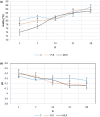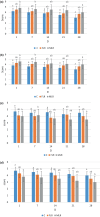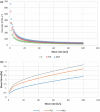Date yogurt supplemented with Lactobacillus rhamnosus (ATCC 53103) encapsulated in wild sage (Salvia macrosiphon) mucilage and sodium alginate by extrusion: The survival and viability against the gastrointestinal condition, cold storage, heat, and salt with low pH
- PMID: 39479610
- PMCID: PMC11521656
- DOI: 10.1002/fsn3.4304
Date yogurt supplemented with Lactobacillus rhamnosus (ATCC 53103) encapsulated in wild sage (Salvia macrosiphon) mucilage and sodium alginate by extrusion: The survival and viability against the gastrointestinal condition, cold storage, heat, and salt with low pH
Abstract
The efficacy of probiotics in providing health benefits may be related to their ability to survive at a sufficient concentration of 106 CFU/g during storage in food and colonization in the gastrointestinal tract. Microencapsulation is a viable method to improve the survivability of probiotics under harsh environmental conditions. In this research, microencapsulated Lactobacillus rhamnosus (MLR) was produced by a two-layer extrusion technique with sodium alginate and wild sage (Salvia macrosiphon) mucilage (SMM) in varying concentrations ranging from 0.2% to 0.8% as the first and second wall materials, respectively. The microencapsulation efficiency and second layer diameter of beads increased significantly with the increase in SMM concentrations. Microencapsulated Lactobacillus rhamnosus (LR) maintained its minimal concentration (6 log CFU/g) during 9 min at 72°C. The MLR-date yogurt (DY) sample had the lowest pH, highest acidity, and highest survival rate among the others at the end of storage. In simulated gastrointestinal conditions (SGC), the survival rates of free LR (FLR) and MLR were 45% and 47% on the 14th day of storage, respectively. In sensory properties, MLR had the highest score in odor and texture parameters but not in others. The MLR viscosity (666.3 mPa·s-1) and SEM images show a relatively denser structure for MLR. In conclusion, this study emphasized the potential of using double-layered beads to protect probiotics, providing valuable inspiration for developing new functional foods with higher survival ability in harsh conditions.
Keywords: Lactobacillus rhamnosus; Salvia macrosiphon; extrusion; heat stress; simulated gasterointestinal condition.
© 2024 The Author(s). Food Science & Nutrition published by Wiley Periodicals LLC.
Conflict of interest statement
The authors declare that they do not have any conflict of interest.
Figures







Similar articles
-
Encapsulation of Lacticaseibacillus rhamnosus by Extrusion Method to Access the Viability in Saffron Milk Dessert and Under Simulated Gastrointestinal Conditions.Food Sci Nutr. 2024 Oct 23;12(11):9714-9726. doi: 10.1002/fsn3.4510. eCollection 2024 Nov. Food Sci Nutr. 2024. PMID: 39619975 Free PMC article.
-
Aloe vera jelly dessert supplemented with Lactobacillus curvatus encapsulated in Plantago major mucilage and sodium alginate: Characterization of physicochemical, sensory properties and survivability against low pH, salt, heat, and cold storage.Food Sci Nutr. 2024 Feb 13;12(5):3377-3390. doi: 10.1002/fsn3.4003. eCollection 2024 May. Food Sci Nutr. 2024. PMID: 38726455 Free PMC article.
-
The effect of alginate and chitosan concentrations on some properties of chitosan-coated alginate beads and survivability of encapsulated Lactobacillus rhamnosus in simulated gastrointestinal conditions and during heat processing.J Sci Food Agric. 2014 Aug;94(11):2210-6. doi: 10.1002/jsfa.6541. Epub 2014 Feb 13. J Sci Food Agric. 2014. PMID: 24343670
-
An in vitro gastrointestinal model to evaluate the tolerance of encapsulated Lactobacillus and Lactococcus strains with synbiotic containing lactobionic acid via lyophilization technique to harsh gastric conditions during storage time.Eur J Pharm Biopharm. 2024 Apr;197:114147. doi: 10.1016/j.ejpb.2023.11.012. Epub 2023 Nov 14. Eur J Pharm Biopharm. 2024. PMID: 37967725
-
Development of antioxidant rich fruit supplemented probiotic yogurts using free and microencapsulated Lactobacillus rhamnosus culture.J Food Sci Technol. 2016 Jan;53(1):667-75. doi: 10.1007/s13197-015-1997-7. Epub 2015 Aug 26. J Food Sci Technol. 2016. PMID: 26787986 Free PMC article.
Cited by
-
Advancing Probiotic Delivery in Functional Yogurt: Encapsulation in Prebiotic-Based Matrices.Foods. 2025 Apr 20;14(8):1423. doi: 10.3390/foods14081423. Foods. 2025. PMID: 40282824 Free PMC article.
References
-
- Akbari, A. , Gänzle, M. G. , & Wu, J. (2023). Cruciferin improves stress resistance and simulated gastrointestinal survival of probiotic Limosilactobacillus reuteri in the model encapsulation system. Food Hydrocolloids for Health, 3, 100118. 10.1016/j.fhfh.2023.100118 - DOI
-
- Ali, U. , Saeed, M. , Ahmad, Z. , Shah, F.‐U.‐H. , Rehman, M. A. , Mehmood, T. , Waseem, M. , Hafeez, H. , Azam, M. , & Rahman, A. (2023). Stability and survivability of alginate gum‐coated Lactobacillus rhamnosus GG in simulated gastrointestinal conditions and probiotic juice development. Journal of Food Quality, 2023b, 1–13. 10.1155/2023/3660968 - DOI
-
- Anjum, N. , Zahoor, I. , Trilokia, M. , & Bhat, A. (2023). Encapsulation technologies in the food industry: Novel and alternative methods in food processing, biotechnological, physicochemical, and mathematical approaches, chapter 12 (1st ed., p. 287). Apple Academic Press Inc. 10.1201/9781003328605-15 - DOI
-
- Ashraf, Z. , & Hamidi‐Esfahani, Z. (2011). Date and date processing: A review. Food Reviews International, 27(2), 101–133. 10.1080/87559129.2010.535231 - DOI
-
- Banan, Z. M. , Yaghobfar, A. , & Mojab, F. (2023). The chemical composition of Salvia macrosiphon seed: The chemical composition of Salvia macrosiphon seed. Iranian Journal of Pharmaceutical Sciences, 19(2), 166–175.
LinkOut - more resources
Full Text Sources

